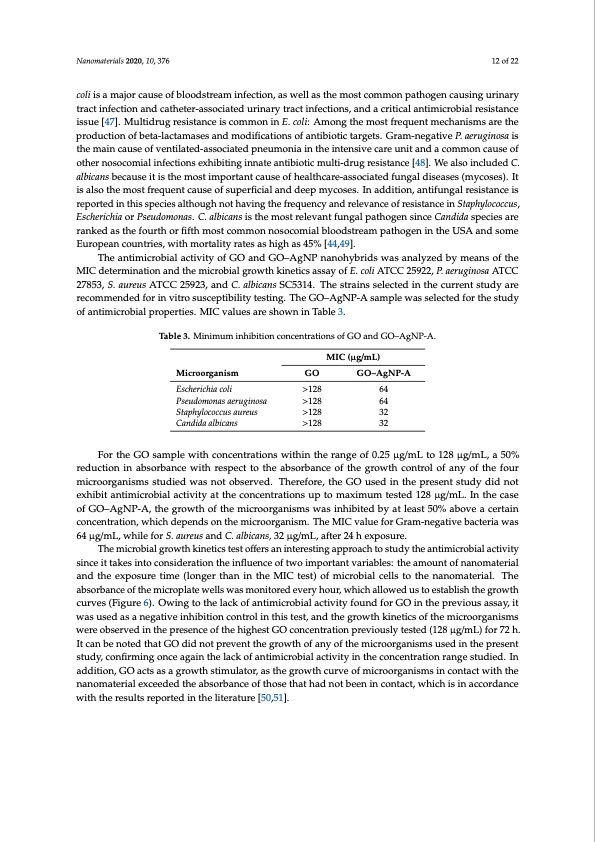
PDF Publication Title:
Text from PDF Page: 012
Nanomaterials 2020, 10, 376 12 of 22 coli is a major cause of bloodstream infection, as well as the most common pathogen causing urinary tract infection and catheter-associated urinary tract infections, and a critical antimicrobial resistance issue [47]. Multidrug resistance is common in E. coli: Among the most frequent mechanisms are the production of beta-lactamases and modifications of antibiotic targets. Gram-negative P. aeruginosa is the main cause of ventilated-associated pneumonia in the intensive care unit and a common cause of other nosocomial infections exhibiting innate antibiotic multi-drug resistance [48]. We also included C. albicans because it is the most important cause of healthcare-associated fungal diseases (mycoses). It is also the most frequent cause of superficial and deep mycoses. In addition, antifungal resistance is reported in this species although not having the frequency and relevance of resistance in Staphylococcus, Escherichia or Pseudomonas. C. albicans is the most relevant fungal pathogen since Candida species are ranked as the fourth or fifth most common nosocomial bloodstream pathogen in the USA and some European countries, with mortality rates as high as 45% [44,49]. The antimicrobial activity of GO and GO–AgNP nanohybrids was analyzed by means of the MIC determination and the microbial growth kinetics assay of E. coli ATCC 25922, P. aeruginosa ATCC 27853, S. aureus ATCC 25923, and C. albicans SC5314. The strains selected in the current study are recommended for in vitro susceptibility testing. The GO–AgNP-A sample was selected for the study of antimicrobial properties. MIC values are shown in Table 3. Table 3. Minimum inhibition concentrations of GO and GO–AgNP-A. Microorganism Escherichia coli Pseudomonas aeruginosa Staphylococcus aureus Candida albicans MIC (μg/mL) GO GO–AgNP-A >128 64 >128 64 >128 32 >128 32 For the GO sample with concentrations within the range of 0.25 μg/mL to 128 μg/mL, a 50% reduction in absorbance with respect to the absorbance of the growth control of any of the four microorganisms studied was not observed. Therefore, the GO used in the present study did not exhibit antimicrobial activity at the concentrations up to maximum tested 128 μg/mL. In the case of GO–AgNP-A, the growth of the microorganisms was inhibited by at least 50% above a certain concentration, which depends on the microorganism. The MIC value for Gram-negative bacteria was 64 μg/mL, while for S. aureus and C. albicans, 32 μg/mL, after 24 h exposure. The microbial growth kinetics test offers an interesting approach to study the antimicrobial activity since it takes into consideration the influence of two important variables: the amount of nanomaterial and the exposure time (longer than in the MIC test) of microbial cells to the nanomaterial. The absorbance of the microplate wells was monitored every hour, which allowed us to establish the growth curves (Figure 6). Owing to the lack of antimicrobial activity found for GO in the previous assay, it was used as a negative inhibition control in this test, and the growth kinetics of the microorganisms were observed in the presence of the highest GO concentration previously tested (128 μg/mL) for 72 h. It can be noted that GO did not prevent the growth of any of the microorganisms used in the present study, confirming once again the lack of antimicrobial activity in the concentration range studied. In addition, GO acts as a growth stimulator, as the growth curve of microorganisms in contact with the nanomaterial exceeded the absorbance of those that had not been in contact, which is in accordance with the results reported in the literature [50,51].PDF Image | Graphene Oxide–Silver Nanoparticle Nanohybrids

PDF Search Title:
Graphene Oxide–Silver Nanoparticle NanohybridsOriginal File Name Searched:
nanomaterials-10-00376.pdfDIY PDF Search: Google It | Yahoo | Bing
Turbine and System Plans CAD CAM: Special for this month, any plans are $10,000 for complete Cad/Cam blueprints. License is for one build. Try before you buy a production license. More Info
Waste Heat Power Technology: Organic Rankine Cycle uses waste heat to make electricity, shaft horsepower and cooling. More Info
All Turbine and System Products: Infinity Turbine ORD systems, turbine generator sets, build plans and more to use your waste heat from 30C to 100C. More Info
CO2 Phase Change Demonstrator: CO2 goes supercritical at 30 C. This is a experimental platform which you can use to demonstrate phase change with low heat. Includes integration area for small CO2 turbine, static generator, and more. This can also be used for a GTL Gas to Liquids experimental platform. More Info
Introducing the Infinity Turbine Products Infinity Turbine develops and builds systems for making power from waste heat. It also is working on innovative strategies for storing, making, and deploying energy. More Info
Need Strategy? Use our Consulting and analyst services Infinity Turbine LLC is pleased to announce its consulting and analyst services. We have worked in the renewable energy industry as a researcher, developing sales and markets, along with may inventions and innovations. More Info
Made in USA with Global Energy Millennial Web Engine These pages were made with the Global Energy Web PDF Engine using Filemaker (Claris) software.
Infinity Turbine Developing Spinning Disc Reactor SDR or Spinning Disc Reactors reduce processing time for liquid production of Silver Nanoparticles.
| CONTACT TEL: 608-238-6001 Email: greg@infinityturbine.com | RSS | AMP |